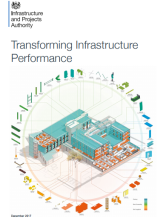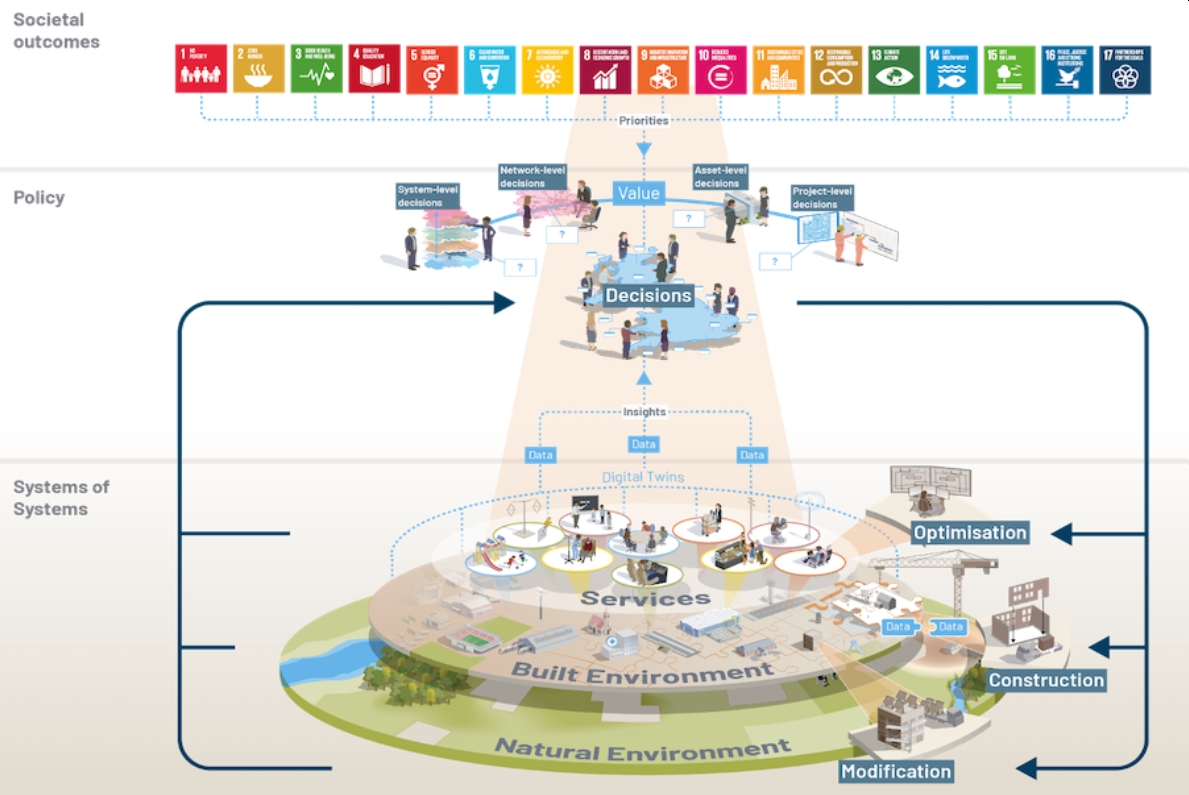Transforming Infrastructure Performance
Contents |
[edit] Overview
On 6 December 2017, the Infrastructure and Projects Authority (IPA) published plans to improve infrastructure and boost the productivity of the construction sector with the intention of saving £15 billion a year on economic infrastructure such as transport and energy networks, and social infrastructure such as schools and hospitals.
(Ref. https://www.gov.uk/government/publications/transforming-infrastructure-performance)
This followed a series of other significant announcements for the industry:
- 22 November 2017, Autumn Budget 2017.
- 27 November 2017, Industrial Strategy: building a Britain fit for the future.
- 29 November 2017, details of the Construction Sector Deal.
Transforming Infrastructure Performance (TIP) is a long-term change programme with a ten year horizon to tackle systemic problems with the performance of UK infrastructure. It also describes the immediate priorities for the IPA, and was revealed alongside a revised National Infrastructure and Construction Pipeline which sets out £600 billion of public and private infrastructure investment over the next ten years.
The programme explains out how the government will ensure pipeline projects are delivered quickly and efficiently, using the government’s influence to drive modern methods of construction, as well as addressing how lessons learned will be applied to efficiency and productivity in transport. Government spending accounts for a quarter of all construction projects, and this purchasing power can be used to drive innovation and encourage investment in methods such as off-site manufacturing, which they suggest could reduce waste by 90% and speed up delivery times by 60%.
The TIP programme will be led by the IPA and is intended to improve the ways in which infrastructure is planned, procured and delivered, focussing on the whole life performance of systems, rather than the capital efficiency of individual projects.
It defines the core issues as:
- Prioritising investment in the right projects.
- Improving productivity in delivery.
- Maximising the overall benefits of infrastructure investment.
The report is set out in four sections:
- Benchmarking for better performance.
- Alignment and integration.
- Procurement for growth.
- Smarter infrastructure.
The immediate priorities for the first two years are:
- Establishing a new IPA benchmarking team to define cost and performance benchmarks.
- Developing a framework for cross-sector integration.
- Rolling out the Procuring for Growth Balanced Scorecard.
- A presumption in favour of offsite construction by 2019.
- Supporting delivery of the Construction Sector Deal.
- Using digital technology and innovation to extract maximum whole life value from infrastructure.
- Supporting and assuring projects.
In addition, a Transport Infrastructure Efficiency Strategy has been produced by Crossrail, Highways England, HS2 Ltd, Network Rail, Transport for London, and the Department for Transport. The Strategy sets out seven core challenges to boost efficiency and productivity. Andrew Wolstenholme, (then CEO of Crossrail and co-chair of the Construction Leadership Council (CLC)) will chair a Transport Infrastructure Efficiency Taskforce (TIET) to oversee delivery of the TIP programme and the TIES, alongside the IPA and CLC. For more information see: Transport infrastructure efficiency strategy.
Tony Meggs, Chief Executive of the IPA, said; “Publishing our Transforming Infrastructure Performance (TIP) programme today demonstrates our commitment to tackling the annual £15 billion productivity gap in construction. The IPA has a significant role to play in helping to create a more productive and innovative sector. We want to maintain confidence in the sector and will work alongside industry, using our purchasing power to drive the adoption of modern methods of construction in both new and existing infrastructure.”
Andrew Wolstenholme said; “The Transforming Infrastructure Performance programme presents a huge opportunity for the industry and government to reap the economic gains from improving productivity during the delivery of the UK’s £600 billion infrastructure pipeline."
[edit] Updates
In September 2018, the Prime Minister announced a shortlist of 10 city regions that will benefit from £840 million to upgrade public transport links. The shortlist marks the next stage of the £1.7bn Transforming Cities Fund.
The local authorities that will bid for a share of the funding are Derby and Nottingham, Leicester City, the North East, Norwich, Plymouth, Portsmouth, Southampton, Sheffield, Stoke-on-Trent, and West Yorkshire. These regions will each receive an initial £50,000 before decisions are made as to the relative strength of each bid.
The allocation of new funding over the next four years is intended to improve transport links in city regions, giving better access to jobs and helping businesses with better infrastructure such as; new bus routes between residential areas and major employment hubs, congestion-tackling smart technology, docking stations for electric bikes, and so on.
Prime Minister Theresa May said; "These improvements to vital infrastructure will help spread growth beyond London and empower local businesses to create more, better-paying jobs – opening up more opportunities to help people get on in life and be rewarded for their hard work."
[edit] 2021 publication
In September 2021 the government published Transforming Infrastructure Performance (TIP): Roadmap to 2030. This succeeded the Government Construction Strategy and sits alongside the Construction Playbook and the National Infrastructure Strategy. It ends: '...what is seen as an artificial separation between infrastructure and construction'. It articulates: '...a consistent shared vision for the future of the built environment, including the role that the government plays through its construction projects.'
In the introduction, Nick Smallwood (Chief Executive Officer of the Infrastructure and Projects Authority and Head of Government's Project Delivery Function) states:
"TIP’s Roadmap to 2030 describes a vision for the future in which we collectively prioritise the societal outcomes we need, and use modern digital approaches and technologies, alongside improved delivery models to achieve them. Achieving that vision requires a system for designing, constructing and operating in the built environment that is more resilient, adaptive and sustainable, and that can better withstand the inevitable shifts and changes we will see in the coming decades."
"The Roadmap builds on the progress we have made since the launch of TIP in 2017, and the landmark publication of the National Infrastructure Strategy in November 2020 and the 25 Year Environment Plan in 2018."
It includes a built environment model that: "...a envisages a new approach to decision making that is founded on an understanding of the interlinked nature of our infrastructure systems."
It also includes an Information Management Mandate which replaces the Level 2 BIM mandate announced in 2011.
For more information see: Information Management Mandate.
[edit] Related articles on Designing Buildings Wiki
- Autumn Budget 2017.
- Balanced scorecard.
- Construction 2025.
- Construction industry organisation.
- Construction Innovation Hub.
- Construction Leadership Council.
- Construction sector deal.
- Construction Sector Deal launch.
- Delivering an infrastructure revolution.
- Government construction strategy.
- ICE recommendations for the Government Construction Strategy 2018 update.
- Industrial Strategy: building a Britain fit for the future.
- Information Management Mandate.
- Infrastructure and Projects Authority.
- Manufacturing Technology Centre.
- Modern methods of construction.
- Procurement policy note PPN.
- Transforming Construction Alliance.
- Transport infrastructure efficiency strategy.
Featured articles and news
RTPI leader to become new CIOB Chief Executive Officer
Dr Victoria Hills MRTPI, FICE to take over after Caroline Gumble’s departure.
Social and affordable housing, a long term plan for delivery
The “Delivering a Decade of Renewal for Social and Affordable Housing” strategy sets out future path.
A change to adoptive architecture
Effects of global weather warming on architectural detailing, material choice and human interaction.
The proposed publicly owned and backed subsidiary of Homes England, to facilitate new homes.
How big is the problem and what can we do to mitigate the effects?
Overheating guidance and tools for building designers
A number of cool guides to help with the heat.
The UK's Modern Industrial Strategy: A 10 year plan
Previous consultation criticism, current key elements and general support with some persisting reservations.
Building Safety Regulator reforms
New roles, new staff and a new fast track service pave the way for a single construction regulator.
Architectural Technologist CPDs and Communications
CIAT CPD… and how you can do it!
Cooling centres and cool spaces
Managing extreme heat in cities by directing the public to places for heat stress relief and water sources.
Winter gardens: A brief history and warm variations
Extending the season with glass in different forms and terms.
Restoring Great Yarmouth's Winter Gardens
Transforming one of the least sustainable constructions imaginable.
Construction Skills Mission Board launch sector drive
Newly formed government and industry collaboration set strategy for recruiting an additional 100,000 construction workers a year.
New Architects Code comes into effect in September 2025
ARB Architects Code of Conduct and Practice available with ongoing consultation regarding guidance.
Welsh Skills Body (Medr) launches ambitious plan
The new skills body brings together funding and regulation of tertiary education and research for the devolved nation.
Paul Gandy FCIOB announced as next CIOB President
Former Tilbury Douglas CEO takes helm.
UK Infrastructure: A 10 Year Strategy. In brief with reactions
With the National Infrastructure and Service Transformation Authority (NISTA).
























